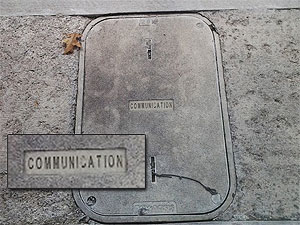Recently, I spotted this utility marker in the middle of the sidewalk in my neighborhood. The word “COMMUNICATION” was pressed in the center ages ago, and the marker itself has remained fixed in that spot despite obvious changes in the concrete around it. This vision made me think about how we communicate in our middle schools. In fact, the image brought forth two diametrically opposed viewpoints about communication in education.
The first perspective is a positive one. Just like this fixed utility marker, it is critical that every school have a solid communication plan that responds in a consistent manner with every stakeholder, even when stakeholders and the community change. But how do we make this happen?
First, every faculty and staff member needs to know that language is the binding agent that holds together the school-to-home relationship and builds trust with the community. There needs to be an individual and collective commitment to that unwavering fact. Once that commitment has been made, everyone also needs to know the school’s expectations for written, spoken, and nonverbal communication with students and stakeholders. What does caring and consistent communication sound like? What does it look like? What does it act like? Uncovering the answers to these questions starts when we assess the solidity of our school’s communication plans.
It is a task that needs to be done at the beginning of the year with the involvement of every grade level and staff member and then revisited throughout the year. If you already have communication templates to help faculty and staff document and capture their conversations, take a look at them to see how accurate and user-friendly they are. If you don’t have templates, it’s time to develop them.
In addition, if you provide faculty and staff with suggested scripts (words and phrases) to help them communicate with care and consistency, it may be time to reread them and see how accurate, culturally-sensitive, and customer-friendly they are. If you don’t have those scripts in place, it’s time to develop those, as well.
This is also relevant to how we communicate with each other in the hallways, conferences, team-meetings, the cafeteria, and in e-mail messages. Obviously, we don’t need to document all of those conversations, but we should start paying attention to them. Do we use language with care and consistency with each other like professional educators modeling good communication skills? Or do we pass each other in our haste without greetings or salutations? Do we rattle off e-mails without regard to tone? Students will pick up the communicative behaviors we show them. Therefore, all of this work about communication is necessary because language is critical both outside and inside the school walls.
While the picture above did make a positive impression on me, it also conjured up a negative thought about how we tend to communicate in our middle schools. The utility marker is, as aforementioned, solid and consistent in the midst of change. However, if our communication plans are inflexible and do not adjust to the communities around us or their communication needs, then they are fundamentally flawed.
Many schools have changed, and those changes are remarkable. Weekly newsletters are now on the web. Teachers are writing blogs to keep students informed. Principals are using Twitter and Facebook to tell families about upcoming events. All of the new ways we communicate with our stakeholders show that we are adjusting. However, there is always room for improvement, and here it is with school-to-home communication: Where can stakeholders communicate back to us? Where can they openly share their ideas?
We talk about an open door policy, but how is that put into action besides PTA meetings, school board discussions, and the occasional principal’s chat? We should keep using Twitter and Facebook, but instead of reporting events and posting pictures, we can start asking questions. We should continue blogging, but instead of informing, we can infuse inquiry. We should keep on using Google, but instead of sharing documents in Drive, we can set up Communities in Google+ where everyone can dialogue in the space. The possibilities are endless and boundless.
Just as the COMMUNICATION utility marker has a solid fixed wall around it, we must be sure that we don’t have walls around our school communication plans that keep stakeholders out. If language and communication are the glue holding us together, everyone must have equal and reciprocal access to that critical binding agent.
This We Believe Characteristics:
|
Haiku
Language is a tool
Shimmering blossom that blooms
Who tends the garden?
